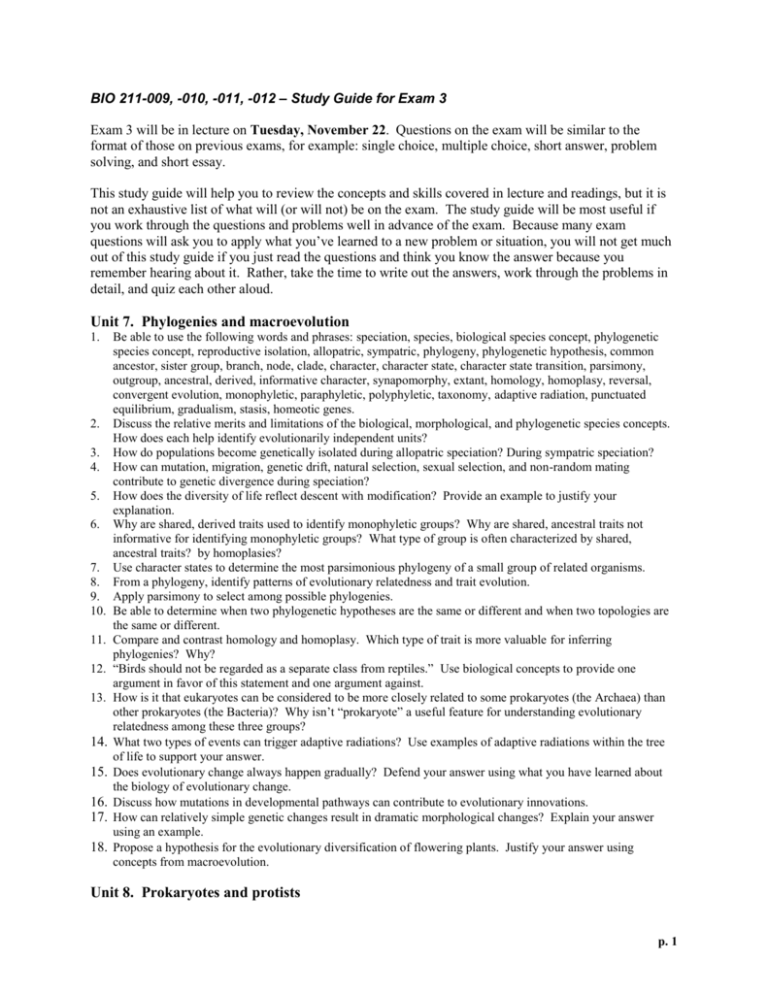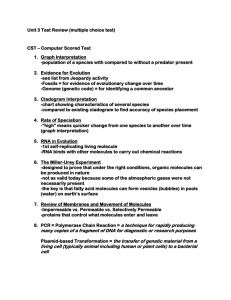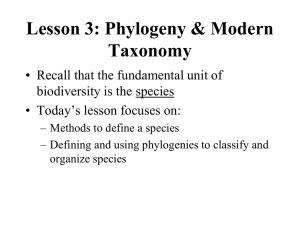Phylogenies
advertisement

BIO 211-009, -010, -011, -012 – Study Guide for Exam 3 Exam 3 will be in lecture on Tuesday, November 22. Questions on the exam will be similar to the format of those on previous exams, for example: single choice, multiple choice, short answer, problem solving, and short essay. This study guide will help you to review the concepts and skills covered in lecture and readings, but it is not an exhaustive list of what will (or will not) be on the exam. The study guide will be most useful if you work through the questions and problems well in advance of the exam. Because many exam questions will ask you to apply what you’ve learned to a new problem or situation, you will not get much out of this study guide if you just read the questions and think you know the answer because you remember hearing about it. Rather, take the time to write out the answers, work through the problems in detail, and quiz each other aloud. Unit 7. Phylogenies and macroevolution 1. 2. 3. 4. 5. 6. 7. 8. 9. 10. 11. 12. 13. 14. 15. 16. 17. 18. Be able to use the following words and phrases: speciation, species, biological species concept, phylogenetic species concept, reproductive isolation, allopatric, sympatric, phylogeny, phylogenetic hypothesis, common ancestor, sister group, branch, node, clade, character, character state, character state transition, parsimony, outgroup, ancestral, derived, informative character, synapomorphy, extant, homology, homoplasy, reversal, convergent evolution, monophyletic, paraphyletic, polyphyletic, taxonomy, adaptive radiation, punctuated equilibrium, gradualism, stasis, homeotic genes. Discuss the relative merits and limitations of the biological, morphological, and phylogenetic species concepts. How does each help identify evolutionarily independent units? How do populations become genetically isolated during allopatric speciation? During sympatric speciation? How can mutation, migration, genetic drift, natural selection, sexual selection, and non-random mating contribute to genetic divergence during speciation? How does the diversity of life reflect descent with modification? Provide an example to justify your explanation. Why are shared, derived traits used to identify monophyletic groups? Why are shared, ancestral traits not informative for identifying monophyletic groups? What type of group is often characterized by shared, ancestral traits? by homoplasies? Use character states to determine the most parsimonious phylogeny of a small group of related organisms. From a phylogeny, identify patterns of evolutionary relatedness and trait evolution. Apply parsimony to select among possible phylogenies. Be able to determine when two phylogenetic hypotheses are the same or different and when two topologies are the same or different. Compare and contrast homology and homoplasy. Which type of trait is more valuable for inferring phylogenies? Why? “Birds should not be regarded as a separate class from reptiles.” Use biological concepts to provide one argument in favor of this statement and one argument against. How is it that eukaryotes can be considered to be more closely related to some prokaryotes (the Archaea) than other prokaryotes (the Bacteria)? Why isn’t “prokaryote” a useful feature for understanding evolutionary relatedness among these three groups? What two types of events can trigger adaptive radiations? Use examples of adaptive radiations within the tree of life to support your answer. Does evolutionary change always happen gradually? Defend your answer using what you have learned about the biology of evolutionary change. Discuss how mutations in developmental pathways can contribute to evolutionary innovations. How can relatively simple genetic changes result in dramatic morphological changes? Explain your answer using an example. Propose a hypothesis for the evolutionary diversification of flowering plants. Justify your answer using concepts from macroevolution. Unit 8. Prokaryotes and protists p. 1 Bio 211 - Exam 3 study guide 1. 2. 3. 4. 5. 6. 7. 8. 9. 10. 11. 12. 13. 14. 15. 16. 17. 18. 19. 20. Be able to use the following words and phrases: prokaryote, eukaryote, domain, pathogenic, bioremediation, decomposer, extremophile, halophile, thermophile, nitrogen fixation, anaerobe, autotroph, heterotroph, photosynthesis, chemosynthesis, methanogen, conjugation, lateral gene transfer, ingestion, absorption, cilia, flagella, endomembrane system, malaria, amoebae, primary producers, plankton, phytoplankton, endosymbiosis, secondary endosymbiosis, multicellularity, colonial, chlorophyll, algae, meiosis, alternation of generations. Be able to discuss the phylogenetic position, phylogenetic status (i.e., monophyletic, paraphyletic, polyphyletic), and defining characteristics of the following groups: Bacteria, Archaea, Eukarya, Prokaryotes. Be able to discuss the ecological roles and importance to humans of the following groups: Bacteria, Archaea, cyanobacteria. Describe a major difference between Earth’s early atmosphere and the atmosphere of today. Explain the timing and nature of events that were the source of this change. Discuss the relationship between metabolic diversity and ecological diversity in prokaryotes. Discuss the relationship between phylogenetic diversity and metabolic diversity in prokaryotes. Use photosynthesis as an example. What is likely to be the source of energy for the production of ATP in pathogenic bacteria? Hydrothermal vent bacteria? Cyanobacteria? Explain. Why are extremophiles important components of biological diversity? If you were to map nitrogen fixation onto a phylogeny of the prokaryotes, what sort of pattern would emerge? (Hint: your textbook provides information about the metabolic diversity found within specific groups of bacteria and archaea.) Discuss at least three hypotheses that would explain this pattern. Which hypothesis is most likely? Why? Discuss the significance of cyanobacteria for the evolution of biodiversity. In what two different ways have cyanobacteria played a critical role in the diversification of life? Be able to discuss the phylogenetic position, phylogenetic status, and defining characteristics of the following groups: green algae, red algae, brown algae, land plants, choanoflagellates, fungi, animals. Be able to discuss the ecological roles and importance to humans of the following groups: green algae, red algae, brown algae, diatoms, dinoflagellates, slime molds. Discuss the evolutionary origin of the following traits: mitochondria, chloroplasts, cell wall, multicellularity. Which are thought to have evolved once and which more than once? How is this reflected in the phylogeny of Eukarya? Outline the steps in the endosymbiosis theory for the origin of mitochondria. What did each partner provide the other, and what did each receive in return? Answer the same questions for the origin of chloroplasts. Describe the major sources of evidence in support of the endosymbiosis theory for the evolution of mitochondria and chloroplasts. In particular, be able to show phylogenetic hypotheses in favor of and against the endosymbiosis theory. Discuss the evolutionary history of photosynthetic eukaryotes. Why are “algae” so diverse? “The tree of life as a metaphor for the evolutionary history of all organisms should be replaced with the web of life.” Use biological concepts to explain an argument in favor of this statement. Use biological concepts to explain an argument in opposition to this statement. Discuss the functional and evolutionary significance of each of these evolutionary innovations: organelles, cytoskeleton, multicellularity, meiosis. What is the relationship between meiosis and the alternation of generations? Compare and contrast alternation of generations with life cycles that do not show alternation of generations. Be sure to include at least two similarities and two differences. Unit 9. Plants and fungi 1. 2. Be able to use the following words and phrases: deforestation, desertification, bioprospecting, embryo, bryophyte, moss, pores, vascular tissue, lignin, sporopollenin, fern, ovary, ovules, pollination, seed, cone, gametophyte, sporophyte, spore, zygote, mycorrhizae, saprophyte, yeast, hyphae, mycelium, heterokaryotic, , basidium, ascus, ascocarp, chitin, endophyte, extracellular digestion, lignin peroxidase, cellulase, spore, plasmogamy, karyogamy, sporangium, opisthokont. Be able to discuss the phylogenetic position, phylogenetic status, and defining characteristics of the following groups: green algae, land plants, non-vascular plants, vascular plants, seedless vascular plants, seed plants, gymnosperms, angiosperms. p. 2 Bio 211 - Exam 3 study guide 3. 4. 5. 6. 7. 8. 9. 10. 11. 12. 13. 14. Draw a simplified phylogeny of land plants and map the origin of the following traits: spores, seeds, tracheids, vessels, cuticle, stomata, pollen, flowers, fruits. Describe three ways that the presence of land plants affects the abiotic environment. What challenges are associated with life on land for plants? Discuss the evolutionary innovations within plants that are important for living and reproducing on land. Be able to map these traits onto a phylogeny of the green plants. Discuss the evolutionary radiation of angiosperms. Why are angiosperms so diverse? Be able to discuss the ecological roles and importance to humans of the following groups: ectomycorrhizal fungi, arbuscular mycorrhizal fungi, lichens, endophytes, yeasts, chytrids. Describe two different ways that fungi increase the productivity of terrestrial ecosystems. Discuss the adaptations for decomposition found within the fungi. Compare and contrast reproduction in ascomycetes and basidiomycetes. A great diversity of life cycles can be observed within the multicellular eukaryotes. Which of the following groups include species with alternation of generations: protists, land plants, animals, fungi? Draw a generalized life cycle with alternation of generations and label the following events or structures: sporophyte, gametophyte, meiosis, mitosis, zygote, fertilization, syngamy, spores, gametes. How is this basic plan altered to result in the life cycles of the following organisms: bryophytes, angiosperms, basidiomycetes, animals? Compare and contrast the typical fungal life cycle (for example, as seen in basidiomycetes) with the typical animal life cycle (for example, as seen in vertebrates) and with the typical angiosperm life cycle. Compare and contrast the roles of plants and fungi in the carbon cycle with the roles of bacteria in the nitrogen cycle. Discuss two distinct ways that the surface area:volume problem has been solved within the tree of life. Unit 10. Animals 1. Be able to use the following words and phrases: Cambrian explosion, body plan, diploblast, triploblast, tissue, epithelium, ectoderm, endoderm, mesoderm, asymmetry, radial symmetry, bilateral symmetry, cephalization, pentaradial symmetry, coelom, pseudocoelom, hydrostatic skeleton, protostome, deuterostome, gastrulation, sessile, exoskeleton, endoskeleton, internal fertilization, external fertilization, metamorphosis, water vascular system, pharyngeal gill slits, notochord, dorsal hollow nerve cord. 2. Be able to discuss the phylogenetic position, phylogenetic status, and defining characteristics of the following groups: Porifera, Cnidaria, protostomes, deuterostomes, Annelida, Nematoda, Arthropoda, Platyhelminthes, Mollusca, Echinodermata, Chordata, vertebrates, invertebrates, fishes, amphibians, reptiles, birds, mammals. 3. Draw a simplified phylogeny of animals (including at least six major phyla) and map the origin of the following traits: radial symmetry, bilateral symmetry, diploblasty, triploblasty, coelom, pseudocoelom, segmentation, protostome development, deuterostome development, notochord, pharyngeal gill slits. 4. Draw a simplified phylogeny of deuterostomes (including echinoderms, amphibians, lampreys, lungfish, ray-finned fishes, sharks reptiles, mammals) and map the origin of the following traits: cranium, radial symmetry, pharyngeal slits, cartilaginous skeleton, bony skeleton, vertebrae, jaw, lungs, limbs, amnion, endothermy, notochord. 5. Discuss the importance of the following evolutionary innovations: mesoderm, bilateral symmetry, metamorphosis, desiccation-resistant eggs, jointed appendages. 6. What challenges are associated with life on land for animals? Discuss the evolutionary innovations within the vertebrates that are important for living and reproducing on land, and be able to map these traits onto a phylogeny of the vertebrates. Compare and contrast the adaptations for life on land within the vertebrates with similar adaptations within the arthropods and mollusks. 7. Compare and contrast the role of metamorphosis in the life cycle of animals with a sessile adult stage and in the life cycle of animals with a mobile adult stage. 8. Discuss the evolutionary radiation of arthropods. Why are arthropods so diverse? 9. Use the evolution of vertebrate limbs and jaws to discuss the evolution of novel traits. 10. Compare and contrast adaptations involved in the diversification of the three most species-rich animal lineages: arthropods, molluscs, and vertebrates. 11. Compare and contrast adaptations for life on land within the plants and the vertebrates. 12. Discuss at least three examples of major adaptive radiations within the evolution of animals. Describe the key events that triggered these radiations. p. 3







